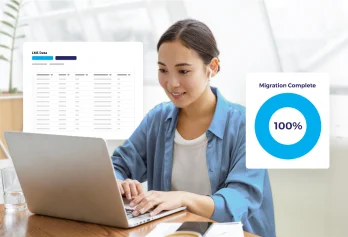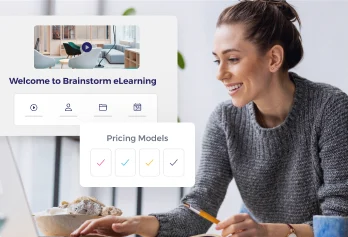Customers expect exceptional support whenever they interact with your brand. A well-placed FAQ section or a responsive service team isn’t enough anymore. Going beyond reactive support means proactively equipping them to get the most out of your offerings. That's where customer training software, or a customer training LMS (learning management system), comes in. It allows you to create a self-service ecosystem that fosters customer independence and satisfaction.
Set the stage for success with onboarding
Think onboarding is just for your employees? Think again. How you onboard your customers sets the tone for your relationship. Research shows that 63% of customers consider the company's onboarding program when making a purchasing decision. It’s the difference between a long-lasting relationship and a short-term stint. Here's why onboarding your customers is important:
- Creates a first impression: Onboarding is your new customer's first impression of your product or service. A smooth and informative process builds trust and assures them they've made a good decision.
- Accelerates value: Onboarding helps customers quickly grasp your product's core features and functionality. This translates to faster time-to-value, meaning they start benefitting sooner.
- Reduces churn: Confused or frustrated customers are more likely to abandon your product. Onboarding reduces churn by enabling them to get the value they expect.
- Boosts customer lifetime value: By helping customers get the most out of your product, onboarding encourages them to use it more frequently and potentially upgrade to premium plans.
How companies can onboard with customer training software
Okay, so now we’ve gone over why onboarding your customers matters. But the looming question you might have is... how do I onboard customers? The solution: a customer training LMS.
A customer training LMS allows you to create customized onboarding experiences that include interactive courses, video tutorials, and assessments. These modules can cover a wide range of topics, from installation guides to in-depth feature demonstrations and best practices. And best of all, you deliver a positive experience to your customers. A Harvard Business Review report found that companies with a structured onboarding program enjoyed a 16% increase in customer satisfaction.
Here are specific ways you can use your customer training software to onboard customers:
1. Create a personalized journey
Generic content can quickly turn into a snoozefest. Personalized learning tailors content to the learner's knowledge and interests, making it more relevant.
- User segmentation: Don't treat all customers the same. Segment users based on their needs and experience level. New users might require basic setup guides, while experienced users might benefit from advanced feature tutorials.
- Branded learning experience: Maintain brand consistency by incorporating your company's logo, colors, and tone of voice throughout the training modules.
2. Make it engaging and interactive
Our attention spans are shorter than ever. Dry, text-heavy content quickly loses learners, leading to disengagement and forgotten information.
- Ditch text overload: Move beyond text-heavy manuals. Use interactive elements like quizzes and simulations to keep learners engaged.
- Microlearning with video: Break down complex topics into bite-sized lessons. Short, informative videos are a great way to visually demonstrate features and functionalities.
- Gamification: Use learning management system gamification like points, badges, and leaderboards to add fun. This can boost motivation and knowledge retention.
3. Seamless access for on-the-go learning
We all have those short bursts of free time throughout the day - waiting for a bus, on a coffee break, or stuck in traffic. On-the-go content allows you to capture these moments and squeeze in valuable information.
- Mobile-friendly design: Ensure your training software is accessible on various devices, including desktops, tablets, and smartphones.
- Self-paced learning: Empower customers to learn at their own pace. The software should allow them to revisit modules and explore topics as needed.
4. Measure and improve for ongoing success
The goal of onboarding and training is to equip customers with the knowledge they need to use your product or service effectively. By analyzing quiz results and completion rates for specific modules, you can identify areas where customers need education.
- Track user progress: Monitor how customers navigate through the training modules. This data can help identify areas where users might be struggling.
- Gather feedback: Collect feedback through post-training surveys or quizzes to understand customer experience with the onboarding process.
- Continual improvement: Use the collected data and feedback to refine your training content and ensure it remains relevant and effective.
Empowering customers to find answers through self-service
Supporting your customers doesn’t stop after onboarding – it’s just the beginning. After initial training, it’s important to empower them to find answers on their own. Why? To foster a sense of self-reliance in using your product and reduce burden on your support teams. The value of self-service customer support is twofold benefiting both customers and organizations.
For customers:
- Faster responses:In a world where quick answers are all we know, instant access to information is key. Self-service lets customers solve problems quickly on their own schedule. 73% of customers think the most important thing a company can do is value their time. Self-service helps businesses do just that.
- Confidence and accessibility: Finding answers independently builds confidence in using your product and provides 24/7 access to information.
For your business:
- Reduced costs and improved efficiency: Approximately 60% of customer care leaders have reported a growth in total customer support calls. This number is expected to grow. Self-service deflects support inquiries, freeing up your team and streamlining operations, ultimately reducing costs.
- Proactive problem solving: Analyzing user searches and common questions within your self-service resources can help identify areas where your training materials need improvement. This allows you to address potential issues proactively and prevent future customer frustration. Information like this can even help inform future product development.
How organizations can support FAQs with a customer training LMS
If you work for a growing organization or an enterprise, you know that customer support teams are constantly bombarded with repetitive questions. While a robust FAQ section can be helpful, it often falls short of providing the depth or context that users crave. This is where customer training software steps in. You can strategically combine your customer training LMS with FAQs to create a powerful self-service ecosystem that encourages customers to find answers independently, reduces support strain, and fosters user engagement. Self-service options are also expected these days – 88% of customers expect brands to have a self-service support portal.
1. Build a robust knowledge base
A well-stocked knowledge base allows customers to find answers to their questions on their own time, without waiting for support.
- Recycle your training: Don't start from scratch. Take training modules you have and turn them into clear, concise knowledge base articles.
- Fill knowledge gaps: Use your LMS data to pinpoint areas people struggle with or what they search for the most. Then, use that intel to build targeted knowledge base content that tackles those specific needs.
2. Make searches smarter
A powerful search function is key. Customers should be able to easily find relevant information using keywords.
- Integrate search with training content: Ensure your knowledge base search results include relevant training modules and video tutorials alongside traditional articles. Consider implementing features like auto-complete suggestions and contextual search results to streamline the process.
- Search insights: Analyze user searches within your customer training LMS and knowledge base. Use this data to identify frequently searched topics or confusing terminology. Refine your knowledge base content and search functionality to address these areas.
3. Help customers when they need it the most
Make it easy for customers to find help within the product itself.
- Learn in the flow:Infuse learning into your customer's experience, so learning fits naturally into their product journey. This makes learning experiences richer, more relevant, and contextual, so customers have the answers they need, when and where they need them.
- Link to relevant training: Integrate links to different training courses across your LMS. This allows users to seamlessly transition from quick in-product guidance to a more in-depth learning experience.
4. Encourage collaborative learning
Build a user community where customers can connect, share experiences, and ask questions.
- Facilitate Q&A: Turn your LMS training modules into discussion hubs. Add forums or Q&A sections where users can ask questions and benefit from peer-to-peer learning.
- Award all-star customers: Implement gamification elements within your LMS community forum. Award badges or points for valuable contributions and consistently helpful answers to incentivize participation. As a bonus, gamification has been shown to boost engagement by 48%.
Train your customers with Absorb LMS
Customer support goes beyond quick fixes. It's about empowering your customers. With Absorb LMS, you can create a seamless onboarding experience, offer ongoing educational resources, and build an easy-to-navigate resource library for your customers. This helps them to find solutions and keeps them coming back for more. Ready to see the difference? Schedule a demo today.





